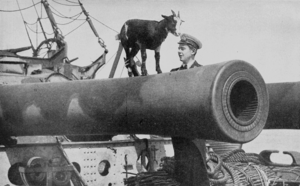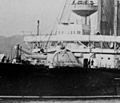BL 12-inch Mk VIII naval gun facts for kids
Quick facts for kids Ordnance BL 12-inch Mk VIII gun |
|
|---|---|

Muzzle of gun on HMS Canopus, 1916
|
|
| Type | Naval Gun, Coastal Defence |
| Place of origin | United Kingdom |
| Service history | |
| In service | 1895–1927 |
| Used by | Royal Navy |
| Wars | World War I |
| Production history | |
| Designer | Woolwich Arsenal |
| Manufacturer | Vickers |
| Variants | Mk VIII, VIIIe, VIIIv |
| Specifications | |
| Mass | 46 tons barrel & breech |
| Length | 445.6 in (11.32 m) |
| Barrel length | 35 ft 5 in (10.80 m) (35.43 calibres) |
|
|
|
| Shell | 850 lb (390 kg) |
| Calibre | 12-inch (304.8 mm) |
| Breech | Welin interrupted screw |
| Recoil | hydraulic |
| Elevation | - 3 / +13.5 degrees |
| Traverse | +150 / -150 degrees |
| Rate of fire | Battleships: 1 in 70 sec. Monitors: 1 in 60 sec. |
| Muzzle velocity | 2,367 ft/s (721 m/s) |
| Effective firing range | 10,000 yd (9,100 m) |
| Maximum firing range | 26,000 yd (24,000 m) |
The BL 12-inch Mark VIII naval gun was a powerful weapon used by the British Navy. It was one of the first big guns designed to use a new type of explosive powder called cordite, which made it much stronger. This gun was also the first large British gun to be "wire-wound." This means strong wire was wrapped around the barrel to make it even tougher. It was a big step forward for British gun design.
These powerful guns were first put on the Majestic-class battleships starting in 1895. Later, from 1899, they were also installed on the Canopus-class battleships.
During World War I, some of these guns were taken off older Majestic-class ships. They were then put onto special ships called Lord Clive-class monitors. These monitors were used to fire shells at enemy positions on land, helping soldiers on the ground.
Land Service
After their time at sea, some of these guns found a new purpose on land. From 1921 to 1926, two guns from the battleship HMS Illustrious were used for coastal defense.
They were placed in special forts called the Tyne Turrets. These turrets protected the mouth of the River Tyne in northeast England.
Problems in Service
Even powerful guns can have problems. When these guns were used on monitors to bombard land targets, they sometimes had issues. Small pieces of copper from the projectile's driving bands would build up inside the gun barrel. This copper needed to be cleaned out often.
A more serious problem was with the inner lining of the gun barrel. The constant friction from the shells moving through the barrel caused the liner to stretch forward. This stretching could create a ridge inside the barrel.
This ridge would collect more copper. If too much copper built up, it could slow the shell down just enough to accidentally trigger its fuze. This caused the shell to explode too early, sometimes even inside the gun barrel or right after leaving it.
This happened several times during the war. Once, a ship called Lord Clive accidentally showered pieces of its own shell over a French destroyer nearby. To fix this, workers would rub down the ridge with a special tool. However, the best solution was to fit new guns with a redesigned inner liner that wouldn't form these ridges.
Images for kids
-
HMS Canopus firing at Turkish forts during the Dardanelles campaign in March 1915. Photo by Ernest Brooks.
-
The right-side 12-inch (305 mm) Mark VIII gun in one of the turrets aboard the battleship HMS Illustrious. The gun's breech (back part) is open.
See also
- List of naval guns
Similar Weapons
- 12"/35 caliber gun - A similar US Navy gun from the same time.
- 12-inch gun M1895 - A US Army gun used for coastal defense.
- Canon de 305 mm Modèle 1893/96 gun - A French naval and railway gun from the same period.







